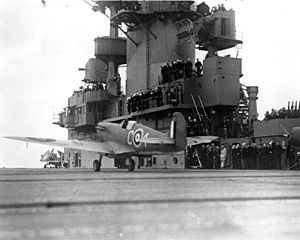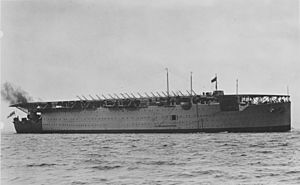Club Run facts for kids
Club Run was the special name for missions that delivered aircraft from Gibraltar to Malta during World War II. These missions were very important because Malta was under attack by Axis forces (Germany and Italy) from 1941 to 1942. Malta was a key British base in the middle of the Mediterranean Sea. It had a good harbor, repair shops, and supplies. This made it a perfect spot for British planes to watch and attack Axis supply ships heading to North Africa.
Malta was so important that Britain even sent fighter planes from its own home defense to protect the island.
Contents
What Was "The Club"?
The ships that helped with these ferry missions were part of a group called Force H. This group was based at Gibraltar, which was nicknamed "The Club." It included powerful warships like the battlecruiser HMS Renown, the aircraft carrier HMS Ark Royal, and the light cruiser HMS Sheffield, along with several destroyers.
The missions themselves were called "Club Runs." People thought of Force H as an exclusive group of the best warships in the Royal Navy. There was even a funny idea of a special "regimental tie" for members of "The Club." It was supposed to be grey, like the Mediterranean Sea, with little "raspberries" scattered on it.
Why Did Malta Need Airplanes?
Malta's air defenses were always under pressure. They constantly needed more planes to replace those lost in battle or damaged. Fighter planes, like Hawker Hurricanes and Supermarine Spitfires, and torpedo bombers, like Fairey Swordfish and Fairey Albacores, were essential.
However, these planes couldn't fly all the way from Gibraltar to Malta on their own. They didn't have enough fuel range. The solution was to use aircraft carriers. These huge ships would sail close enough to Malta, and then the fighter planes would take off from their decks and fly the rest of the way to land at an airfield on Malta.
The First Club Runs
At the start of the war, some leaders thought Malta couldn't be defended. But Winston Churchill, the British Prime Minister, strongly disagreed. In July 1940, he insisted that Hurricane fighters be sent to Malta as soon as possible. This led to the very first Club Run, called Operation Hurry. For this mission, the older aircraft carrier HMS Argus was used.
Challenges and Dangers
The Axis forces soon figured out what the Club Runs were doing. They tried to stop the planes by attacking them while they were flying to Malta. They also tried to bomb the planes on the ground before they could be refueled and armed.
For example, during Operation Calendar, 48 Spitfires were delivered by the United States Navy carrier USS Wasp. But many of them were destroyed on the ground by Axis bombs. However, in the next mission, Operation Bowery, the British were smarter. They got their fighter planes into the air quickly, ready to fight the German Luftwaffe (air force).
The aircraft carriers themselves became big targets for Axis attacks. This meant the Club Runs became more dangerous and needed more protection. Sadly, the British carrier Ark Royal was sunk. The American carrier Wasp was then loaned to Britain for Club Runs in April and May 1942.
So many planes were lost over Malta that the Club Runs became a constant flow of aircraft. Planes were brought to Gibraltar, transferred to carriers, and then flown off to Malta. More planes were even shipped in crates and put together at Gibraltar or on the carriers. This way, one trip from Britain could provide enough planes for two flying-off operations.
Spitfires and Fuel Problems
From early 1942, the British needed Spitfires to fight the newer, more advanced German fighter planes. The older Hurricanes, though tough, were becoming outdated.
A big problem was with the extra fuel tanks that Spitfires needed to fly the long distance to Malta. Sometimes, these external fuel tanks had faults. Because of this, two Club Runs had to be stopped and repeated after repairs in Gibraltar. The planes delivered during Operation Calendar were not properly prepared and were bombed on Malta. For Operation Bowery, the 64 Spitfires needed changes to their fuel tanks while still on board the USS Wasp. It was "embarrassing" that this problem kept happening.
The End of Club Runs
By October 1942, a new solution was found. Special versions of the Spitfire Mk VCs were adapted. They had extra fuel tanks inside and outside, and most of their weapons were removed. This allowed them to fly the 1,100 miles (1,800 km) directly from Gibraltar to Malta! Once they arrived, the changes were reversed, and they became combat-ready. Because of these new long-range Spitfires, the Club Runs were no longer needed.
List of Club Run Operations
- August 1940 - Operation Hurry: 12 Hurricanes flown off HMS Argus
- November 1940 - Operation Coat: off HMS Ark Royal 3 Fulmars for HMS Illustrious
- November 1940 - Operation White: 12 Hurricanes flown off Argus, 8 lost en route after running out of fuel
- April 1941 - Operation Winch: 12 Hurricane IIs flown off Ark Royal
- April 1941 - Operation Dunlop: 22 Hurricanes flown off Ark Royal
- May 1941 - Operation Splice: 48 Hurricane IIs flown off Furious and Ark Royal
- June 1941 - Operation Rocket: 35 Hurricane IIs flown off Furious and Ark Royal
- June 1941 - Operation Tracer: HMS Ark Royal and Victorious flew off 47 Hurricanes to Malta
- June 1941 - Operation Railway I: 22 Hurricanes flown off Ark Royal
- June 1941 - Operation Railway II: 35 Hurricanes off Ark Royal and Furious (7 not launched due to deck accident)
- September 1941 - Operation Status I: 26 Hurricanes flown off Ark Royal
- September 1941 - Operation Status II: 46 Hurricanes flown off Ark Royal and Furious
- October 1941 - Operation Callboy: 11 Albacores and 2 Swordfish flown off Ark Royal
- November 1941 - Operation Perpetual: 37 Hurricanes flown off Ark Royal and Argus (10–12 November 1941)
- February 1942 - Operation Spotter I: 15 Spitfire Mk VBs off HMS Eagle. Operation was stopped because of a fuel tank problem on the Spitfires.
- March 1942 - Operation Spotter II: the 15 repaired Spitfire Mk VBs flown off Eagle on 7 March.
- March 1942 - Operation Picket I: 9 Spitfires off Eagle aborted due to fuel tank fault
- March 1942 - Operation Picket II: 7 Spitfires flown off Eagle and Argus; 6 Albacores unable to fly off Argus
- April 1942 - Operation Calendar: 48 Spitfires flown off from USS Wasp
- May 1942 - Operation Bowery 64 Spitfires: flown off USS Wasp and HMS Eagle (61 arrived).
- May 1942 - Operation LB: 17 Spitfires flown off Eagle; 6 Albacores again failed to fly off
- June 1942 - Operation Style: 32 Spitfires flown off HMS Eagle. Twenty-eight of them arrived safely, four shot down en route.
- June 1942 – Operation Salient: 32 Spitfires from HMS Eagle
- June 1942 - Operation Pinpoint: 31 Spitfires flown off Eagle
- July 1942 - Operation Insect: 28 Spitfires flown off Eagle
- August 1942 - Operation Bellows: 39 Spitfires flown off Furious
- August 1942 - Operation Baritone: 32 Spitfires flown off Furious
- October 1942 – Operation Train: 29 Spitfires flown off Furious
See also



